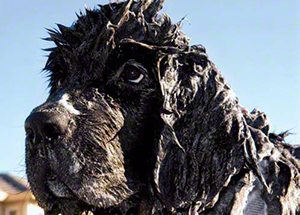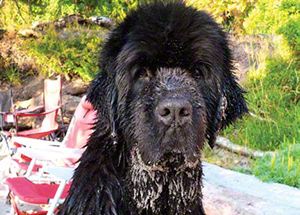The arrival of a new puppy is an exciting event, and the inevitable change in household routine will go much smoother if you’re well-prepared for the arrival of your Newfoundland newcomer. The following items and discussions should help you to get ready – or, if your puppy is already at home, to make sure you’ve covered all the bases. (If you’re not new to dog ownership, some of what’s discussed below will be familiar, but please read through the list anyway, as many of its suggestions are Newf specific. Newfoundlands’ size and breed characteristics mea n that what works for a Lab or a boxer won’t necessarily fill the bill now, or at least not when your new member of the family is full-grown.)
CLEANING UP YOUR PUPPY: GROOMING and BATHING
Newfs need a lot of grooming, plain and simple. If you don’t want to be bothered grooming your dog or don’t want to spend the money taking her to a professional groomer, a Newfoundland is not for you. Even if you plan on using a professional groomer, you’ll need to have a few basic grooming tools at home. Newf coats need regular, frequent attention, so be prepared to do some brushing daily or almost daily, to clean ears and teeth regularly, to trim or grind nails every week or so, and to address any matting or other coat/skin issues that arise. To accomplish all this, you’ll need some tools, though there’s no need to rush out and buy them all at once. Brushes (a pin brush and a slicker brush, appropriately sized) and a comb (a handy variety has fine teeth on one half and medium on the other) are essential, and an undercoat rake is one of the best ways to make sure you’re combing out your dog’s coat all the way down to the skin. A pair of straight-edge grooming shears can be helpful for trimming hair around your dog’s footpads (curved shears do an even better job here), and you’ll need something to deal with your dog’s nails. Heavy nail clippers are needed for thick Newfie nails, or you may wish to consider a nail grinder (many people use Dremel rotary grinders with sanding bands); talking with a vet, groomer, or experienced Newf owner is highly recommended if you’re not comfortable with nail trimming.
Bathing a Newfoundland is not something to squeeze quickly into a hectic schedule; it’s typical for the entire process to take a couple of hours or more for an adult Newf, and that assumes a coat that gets regular attention in between baths. You’ll need shampoo, of course, perhaps conditioner, and several large bath towels to begin the drying process; a chamois, used prior to toweling, is very helpful for removing excess water from the coat. Ideally, you’ll also want to purchase a dog dryer. Even after thorough toweling a Newf will be damp for hours unless you use a dryer, especially in humid weather. Human hair dryers aren’t really appropriate for giant-breed dogs, as most blow heated air, which is not ideal, and such driers lack the necessary volume and velocity to do the job in a reasonable amount of time. Dryers made specifically for dogs – you’ll probably need to order these online, although some specialty dog stores may carry a model or two – are the best, as they produce the necessary volume and air speed, don’t have heating elements, and are built to routinely run the 60 minutes or more it will take to dry a full-grown Newf. (These dryers are loud, though, so you’ll want to introduce your puppy to it gradually and as early in her life as possible.)
Grooming tables are another extremely useful part of the Newf owner’s toolkit, as they spare your back and knees and make drying (indeed, all aspects of grooming) much easier by putting the Newf at a comfortable height and by limiting her movement, although there certainly are many aspects of grooming that can be done with both owner and dog on the floor. Tables that are 42” long are sufficient for many Newfs, though larger dogs will require a 48” table; some tables have legs that allow height adjustment, which many owners find beneficial. While most Newfs can jump up onto a table, it is best to help them down, or provide a ramp, in order to reduce the chance of injury. Keep in mind that it’s important to introduce your dog gradually not only to a grooming table but to all of the processes and equipment used in grooming, which is why it’s helpful, if not essential, to have some if not all of these materials handy when your puppy comes home.

